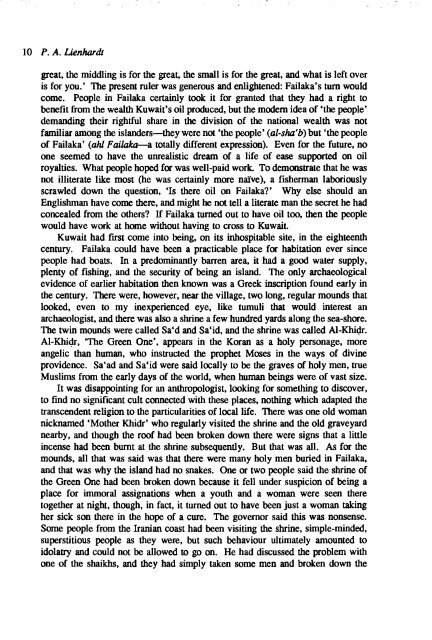1991 No. 1 CONTENTS - Institute of Social and Cultural ...
1991 No. 1 CONTENTS - Institute of Social and Cultural ...
1991 No. 1 CONTENTS - Institute of Social and Cultural ...
You also want an ePaper? Increase the reach of your titles
YUMPU automatically turns print PDFs into web optimized ePapers that Google loves.
10 P. A. Lienhardt<br />
great, the middling is for the great, the small is for the great, <strong>and</strong> what is left over<br />
is for you.' The present ruler was generous <strong>and</strong> enlightened: Failaka's turn would<br />
come. People in Failaka certainly took it for granted that they had a right to<br />
benefit from the wealth Kuwait's oil produced, but the modem idea <strong>of</strong> 'the people'<br />
dem<strong>and</strong>ing their rightful share in the division <strong>of</strong> the national wealth was not<br />
familiar among the isl<strong>and</strong>ers-they were not 'the people' (al-sha'b) but 'the people<br />
<strong>of</strong> Failaka' (ahJ. Failaka-a totally different expression). Even for the future, no<br />
one seemed to have the unrealistic dream <strong>of</strong> a life <strong>of</strong> ease. supported on oil<br />
royalties. What people hoped for was well-paid work. To demonstrate that he was<br />
not illiterate like most (he was certainly more naive), a fisherman laboriously<br />
scrawled down the question, 'Is there oil on Failaka?' Why else should an<br />
Englishman have come there, <strong>and</strong> might he not tell a literate man the secret he had<br />
concealed from the others? If Failaka turned out to have oil too, then the people<br />
would have work at home without having to cross to Kuwait.<br />
Kuwait had fIrst come into being, on its inhospitable site, in the eighteenth<br />
century. Failaka could have been a practicable place for habitation ever since<br />
people had boats. In a predominantly barren area, it had a good water supply,<br />
plenty <strong>of</strong> fishing, <strong>and</strong> the security <strong>of</strong> being an isl<strong>and</strong>. The only archaeological<br />
evidence <strong>of</strong> earlier habitation then known was a Greek inscription found early in<br />
the century. There were, however, near the village, two long, regular mounds that<br />
looked, even to my inexperienced eye, like tumuli that would interest an<br />
archaeologist, <strong>and</strong> there was also a shrine a few hundred yards along the sea-shore.<br />
The twin mounds were called SaId <strong>and</strong> Sa'id, <strong>and</strong> the shrine was called Al-KhiQr.<br />
Al-KhiQr, 'The Green One', appears in the Koran as a holy personage, more<br />
angelic than human, who instructed the prophet Moses in the ways <strong>of</strong> divine<br />
providence. Sa'ad <strong>and</strong> Sa'id were said locally to be the graves <strong>of</strong> holy men, true<br />
Muslims from the early days <strong>of</strong> the world, when human beings were <strong>of</strong> vast size.<br />
It was disappointing for an anthropologist, looking for something to discover,<br />
to fmd no significant cult connected with these places, nothing which adapted the<br />
transcendent religion to the particularities <strong>of</strong> local life. There was one old woman<br />
nicknamed 'Mother Khidr' who regularly visited the shrine <strong>and</strong> the old graveyard<br />
nearby, <strong>and</strong> though the ro<strong>of</strong> had been broken down there were signs that a little<br />
incense had been burnt at the shrine subsequently. But that was all. As for the<br />
mounds, all that was said was that there were many holy men buried in Failaka,<br />
<strong>and</strong> that was why the isl<strong>and</strong> had no snakes. One or two people said the shrine <strong>of</strong><br />
the Green One had been broken down because it fell under suspicion <strong>of</strong> being a<br />
place for immoral assignations when a youth <strong>and</strong> a woman were seen there<br />
together at night, though, in fact, it turned out to have been just a woman taking<br />
her sick son there in the hope <strong>of</strong> a cure. The governor said this was nonsense.<br />
Some people from the Iranian coast had been visiting the shrine, simple-minded,<br />
superstitious people as they were, but such behaviour ultimately amounted to<br />
idolatry <strong>and</strong> could not be allowed to go on. He had discussed· the problem with<br />
one <strong>of</strong> the shaikhs, <strong>and</strong> they had simply taken some men <strong>and</strong> broken down the
















